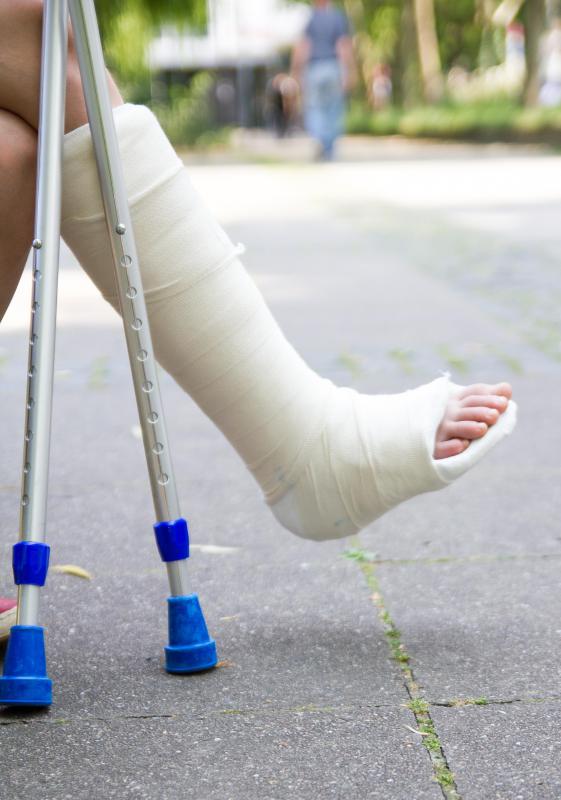At TheHealthBoard, we're committed to delivering accurate, trustworthy information. Our expert-authored content is rigorously fact-checked and sourced from credible authorities. Discover how we uphold the highest standards in providing you with reliable knowledge.
What Is a Distal Fibula Fracture?
The distal fibula is a bone in the lower leg on a human that is situated directionally on the outside of the leg. A common injury to this bone is a fracture, in which the bone becomes cracked as the result of a direct impact or trauma, an excessive twisting motion, or an undue stress on the bone. The fibula is a fairly thin bone, making it more prone to breaks. It is also attached to the ankle, which is an area of the leg exceptionally prone to damage from stress or impact.
Children and athletes are most likely to have a distal fibula fracture, and the condition can be quite painful, depending on the severity of the injury. A stress fracture can cause a very small, hairline crack in the bone, and these are usually the least painful fracture types. The treatment for a hairline stress fracture will be adequate rest and immobilization to allow the bone to repair itself. The RICE treatment — rest, ice, compression, and elevation — is appropriate first aid should such an injury occur. It is often possible to walk on a leg suffering from a minor break, but this risks worsening the injury.

More severe fractures can be exceptionally painful and will require more medical attention. They may also be treated in the same manner as a hairline fracture, though a cast is likely to be put on the leg to prevent excess movement, and the healing time may be fairly prolonged. The most severe distal fibula fractures may require surgery to repair the bone using plates and screws; if the bone has ruptured any surrounding soft tissue, they may also need to be repaired during the surgery. Recovery time from such an injury can be quite long.

The most common way to suffer a fracture of the distal fibula is to roll the ankle severely. This is a common occurrence among children who are still developing coordination and athletes who participate in regular vigorous exercise. Anyone can incur such an injury, however, and the signs of such a break include pain in the lower leg, pain in the ankle, swelling in the lower leg and ankle, and a loss or reduction in mobility. Anti-inflammatory medications may be prescribed to help reduce inflammation, and painkillers can also be used to help reduce pain and discomfort during the healing process.
AS FEATURED ON:
AS FEATURED ON:















Discussion Comments
@Ana1234 - Yeah, I have a few sporty friends and it seems like it's happened a few times with them. I had one who was in the territorial army and had injured her leg, but thought it was a sprain. They had some kind of last exercise they needed to do and she just kept on going, even though she was limping really badly.
Everyone was really impressed when it turned out that she had done it with a fractured ankle, but the medic told her that it was really stupid. It's easy to brush off something when you know you can keep going, but you can end up doing more permanent damage, so it's a bad idea.
I think it's also easy to brush off a stress fracture of this bone as just being a strain or a sprain. I remember when I was a kid my sister managed to hurt her leg (I can't remember how she did it, but we did like to climb trees and mess around in streams and things, so it was probably a fall of some kind) and when she went to my dad he thought, since she was still basically upright, that it probably wasn't a big deal, even though she was really upset. So, we didn't go to the hospital until the next day when it didn't get better.
He felt really guilty when it turned out she had a distal fibula fracture, even though she was soon smiling again. It's the kind of thing that's a hard call to make.
Post your comments